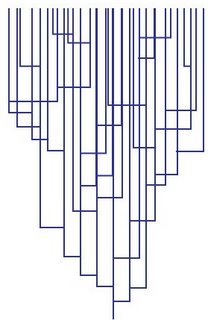On microbial species
OK, this is one of a series of posts in which I will play with ideas that might become a paper.
The problem is this: usually we define a species as a group of related organisms that share genes (or a gene pool, which amounts to the same thing). Sometimes we include also ecological considerations (either in the form of natural selection, or in terms of sharing a niche).
But many microbial species either do not share genes to reproduce, or they can but do not need to. So, the question is sometimes raised whether microbes (of this kind) form species at all, or if there is some replacement term or concept for microbial taxonomy.
Historically, it took a long time to even accept that there were asexual organisms. Darwin discussed hermaphroditic species, but they still had mating types or genders; it was just that a single individual had both kinds. It was long recognised that some plants could propagate vegetatively. But the notion that there were obligately asexual organisms was doubted, for instance, by Fisher as late as 1958 (in the second edition of the Genetical Theory of Natural Selection). George Gaylord Simpson, the famous joint architect of the synthesis and paleontologist, simply denied that asexuals formed species. Call them something else, he said.
But bacteriologists, mycologists, and virologists all continued to name and describe species, even though they could not really make use of the Biological Species Concept of Dobzhansky and Mayr. They relied on their staining properties, the colony shape, the microscopic morphology of the cells, and of course the ecological conditions under which they lived. There was lacking, though, a clear definition of what a species could be for these organisms.
Part of the problem is this: if a species were obligately clonal, then each mutation would make a new clonal lineage:

and we would expect to find not clusters but a carpet of strains more or less evenly distributed. How can we account for this? I will call this the Problem of Homogeneity: why are asexual lineages ever found as groups at all? Why are they homogeneous over time, and stable enough to be called "species"?
I will follow this up in the next post, but I want to get your feedback first.
The problem is this: usually we define a species as a group of related organisms that share genes (or a gene pool, which amounts to the same thing). Sometimes we include also ecological considerations (either in the form of natural selection, or in terms of sharing a niche).
But many microbial species either do not share genes to reproduce, or they can but do not need to. So, the question is sometimes raised whether microbes (of this kind) form species at all, or if there is some replacement term or concept for microbial taxonomy.
Historically, it took a long time to even accept that there were asexual organisms. Darwin discussed hermaphroditic species, but they still had mating types or genders; it was just that a single individual had both kinds. It was long recognised that some plants could propagate vegetatively. But the notion that there were obligately asexual organisms was doubted, for instance, by Fisher as late as 1958 (in the second edition of the Genetical Theory of Natural Selection). George Gaylord Simpson, the famous joint architect of the synthesis and paleontologist, simply denied that asexuals formed species. Call them something else, he said.
But bacteriologists, mycologists, and virologists all continued to name and describe species, even though they could not really make use of the Biological Species Concept of Dobzhansky and Mayr. They relied on their staining properties, the colony shape, the microscopic morphology of the cells, and of course the ecological conditions under which they lived. There was lacking, though, a clear definition of what a species could be for these organisms.
Part of the problem is this: if a species were obligately clonal, then each mutation would make a new clonal lineage:

and we would expect to find not clusters but a carpet of strains more or less evenly distributed. How can we account for this? I will call this the Problem of Homogeneity: why are asexual lineages ever found as groups at all? Why are they homogeneous over time, and stable enough to be called "species"?
I will follow this up in the next post, but I want to get your feedback first.




<< Home